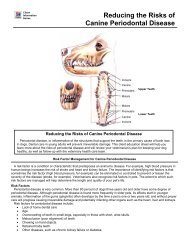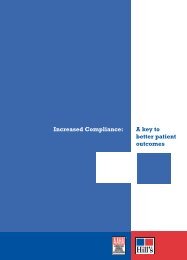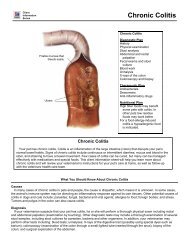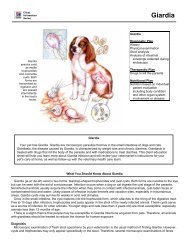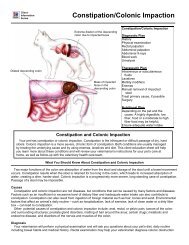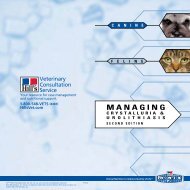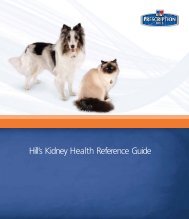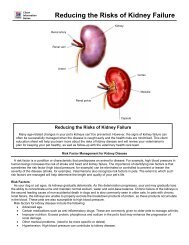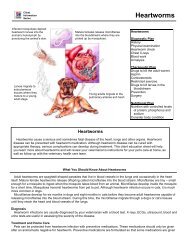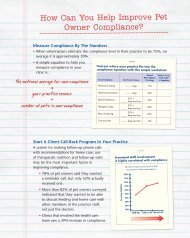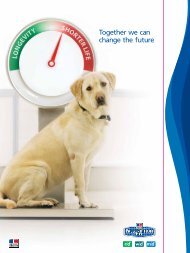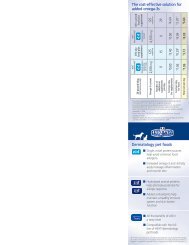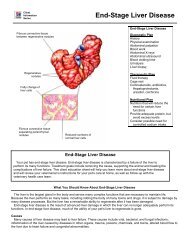Feline Dilated Cardiomyopathy - HillsVet
Feline Dilated Cardiomyopathy - HillsVet
Feline Dilated Cardiomyopathy - HillsVet
Create successful ePaper yourself
Turn your PDF publications into a flip-book with our unique Google optimized e-Paper software.
Client<br />
Information<br />
Series<br />
<strong>Feline</strong> <strong>Dilated</strong> <strong>Cardiomyopathy</strong><br />
A globular-shaped heart with<br />
severe dilation of all four<br />
chambers. Depressed<br />
ventricular contractile<br />
performance occurs.<br />
Ventricular dilation distorts the<br />
atrioventricular valves leading<br />
to mitral regurgitation and<br />
atrial enlargement.<br />
Atrophied papillary muscle<br />
Abnormally thin<br />
ventricular walls<br />
<strong>Dilated</strong> ventricular<br />
chambers<br />
<strong>Feline</strong> <strong>Dilated</strong> <strong>Cardiomyopathy</strong><br />
Diagnostic Plan<br />
History<br />
Physical examination<br />
Chest auscultation<br />
Palpation of femoral pulses and hindlimb<br />
musculature<br />
Blood work<br />
Urinalysis<br />
Electrocardiography<br />
Chest X-rays<br />
Echocardiography<br />
X-rays of the heart and abdominal blood<br />
vessels after dye injection<br />
Plasma taurine analysis<br />
Therapeutic Plan<br />
Enforced rest<br />
Diuretics<br />
Bronchodilators<br />
Oxygen therapy<br />
Removal of fluid from the chest and abdomen<br />
Drugs that dilate blood vessels<br />
Drugs that strengthen the heart<br />
Heparin<br />
Surgery<br />
Nutritional Plan<br />
Nutrition that contains adequate levels of<br />
taurine and avoids excess levels of sodium<br />
<strong>Feline</strong> <strong>Dilated</strong> <strong>Cardiomyopathy</strong><br />
Your cat has dilated cardiomyopathy. <strong>Cardiomyopathy</strong> is a disease of the heart muscle characterized by fluid<br />
build-up in the body and clot formation in the arteries. Common clinical signs include difficult breathing, poor<br />
appetite, weight loss, hind limb weakness and/or paralysis. It is treated with rest, medication and dietary<br />
management. This client education sheet will help you learn more about this condition and will review your<br />
veterinarian’s instructions for your pet’s care at home.<br />
What You Should Know About <strong>Feline</strong> <strong>Dilated</strong> <strong>Cardiomyopathy</strong><br />
The heart has four chambers: two atria on the top of the heart and two ventricles on the bottom. <strong>Dilated</strong><br />
cardiomyopathy is a disease characterized by enlargement of all four heart chambers. The walls of the ventricles are<br />
abnormally thin, and the heart has a severely reduced ability to contract. Cats with dilated cardiomyopathy usually have<br />
congestive heart failure with fluid accumulation in the lungs, abdomen or both. Thromboemboli (clots that obstruct blood<br />
vessels) can sometimes form in the arteries of cats affected by the disease.<br />
Causes<br />
The cause of all cases of dilated cardiomyopathy is unknown. In 1987, it was found that a deficiency of an amino acid<br />
called taurine could cause dilated cardiomyopathy in cats. Hill’s® Science Diet® and Hill’s® Prescription Diet® products<br />
are supplemented with taurine to prevent this nutritional deficiency.<br />
Diagnosis<br />
The first step that your veterinarian will make in diagnosing dilated cardiomyopathy is to thoroughly examine your cat.<br />
During physical examination, heart murmurs and fluid in the chest and abdomen may be detected. Your veterinarian will<br />
carefully check your cat’s pulse and feel its back legs for coolness or unusual firmness caused by thromboembolism.
X-rays of the chest and abdomen are useful for diagnosing heart enlargement and fluid accumulation. Ultrasound of the<br />
heart is necessary to diagnose the condition and function of the heart. ECGs of the heart help show rhythm disturbances<br />
which may further impair normal function. Blood tests and urinalyses are commonly performed to assess the effects of<br />
heart failure on other organs. Your veterinarian may elect to measure plasma taurine levels.<br />
Treatment and Home Care<br />
Your veterinarian may treat the congestive heart failure component of dilated cardiomyopathy with some or all of the<br />
following therapies: low-sodium foods; foods with proper taurine levels; rest; diuretics; oxygen; drugs to strengthen the<br />
heart and dilate blood vessels; and sometimes removal of fluid from the chest and abdomen. Therapy for<br />
thromboembolism includes giving drugs to dilate blood vessels, prevent clotting, and break up clots.<br />
Home care consists of giving all prescribed medications, monitoring your cat for resolution of clinical signs and feeding<br />
your cat based on your veterinarian’s instructions. Some drugs that your veterinarian uses to treat heart disease have side<br />
effects. Report any abnormal behavior – such as poor appetite, vomiting and difficulty breathing – to your veterinarian<br />
immediately. You may need to return to the hospital for diagnostic tests that your veterinarian will use to check the<br />
effectiveness of therapy.<br />
Nutritional Plan<br />
If your cat has dilated cardiomyopathy, your veterinarian may suggest a dietary change based on your pet’s age and<br />
body condition, the clinical signs and the presence or absence of disease in other organs and body systems. When<br />
taurine deficiency is the cause of dilated cardiomyopathy, your veterinarian will recommend taurine supplements or<br />
prescribe a special food that contains adequate amounts of this amino acid. Such foods include the Hill’s® Prescription<br />
Diet® g/d® <strong>Feline</strong> Early Cardiac-Healthy Aging and Hill’s® Science Diet® brand of cat foods. For cats with a diet deficient<br />
in taurine, proper nutrition would be expected to improve the condition.<br />
If your cat has congestive heart failure as a result of dilated cardiomyopathy, your veterinarian may give you special<br />
feeding instructions. Many pets with congestive heart failure benefit from a nutritionally complete but reduced-sodium food.<br />
These foods reduce the workload of the heart by reducing fluid accumulation in the body. Such foods include Hill’s®<br />
Prescription Diet® g/d® <strong>Feline</strong> Early Cardiac-Healthy Aging and Prescription Diet® k/d® <strong>Feline</strong> Renal Health.<br />
Transitioning Food<br />
Unless recommended otherwise by your veterinarian, gradually introduce any new food over a seven-day period. Mix<br />
the new food with your pet’s former food, gradually increasing its proportion until only the new food is fed.<br />
If your pet is one of the few that doesn’t readily accept a new food, try warming the canned food to body temperature,<br />
hand feeding for the first few days, or mixing the dry food with warm water (wait ten minutes before serving). Feed only<br />
the recommended food. Don't feed additional salt or any snacks that may contain sodium. Be patient but firm with your pet.<br />
This is important because the success or failure of treatment depends to a large degree on strict adherence to the new<br />
food.<br />
Presented as an educational service by<br />
Client’s Name:<br />
Patient’s Name:<br />
Medication(s):<br />
Home Care Instructions<br />
_________________________________________________________<br />
_________________________________________________________<br />
_________________________________________________________<br />
Nutritional Recommendation: ___________________________________________________<br />
Follow-Up Appointment: _______________________________________________________<br />
(Hospital Stamp Area Above)<br />
REGULAR VISITS WILL HELP OUR VETERINARY HEALTH CARE TEAM PROVIDE FOR YOUR PET’S BEST INTEREST.<br />
©2011 Hill’s Pet Nutrition, Inc.<br />
®/ Trademarks owned by Hill’s Pet Nutrition, Inc.



